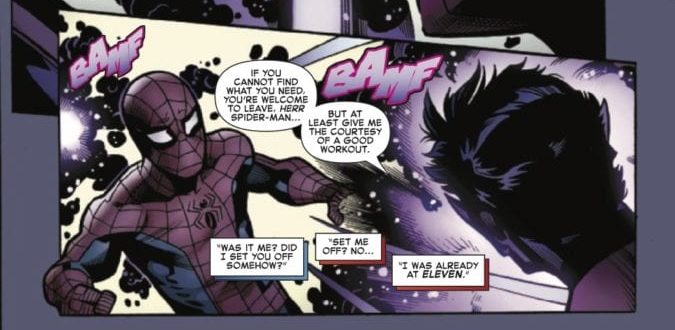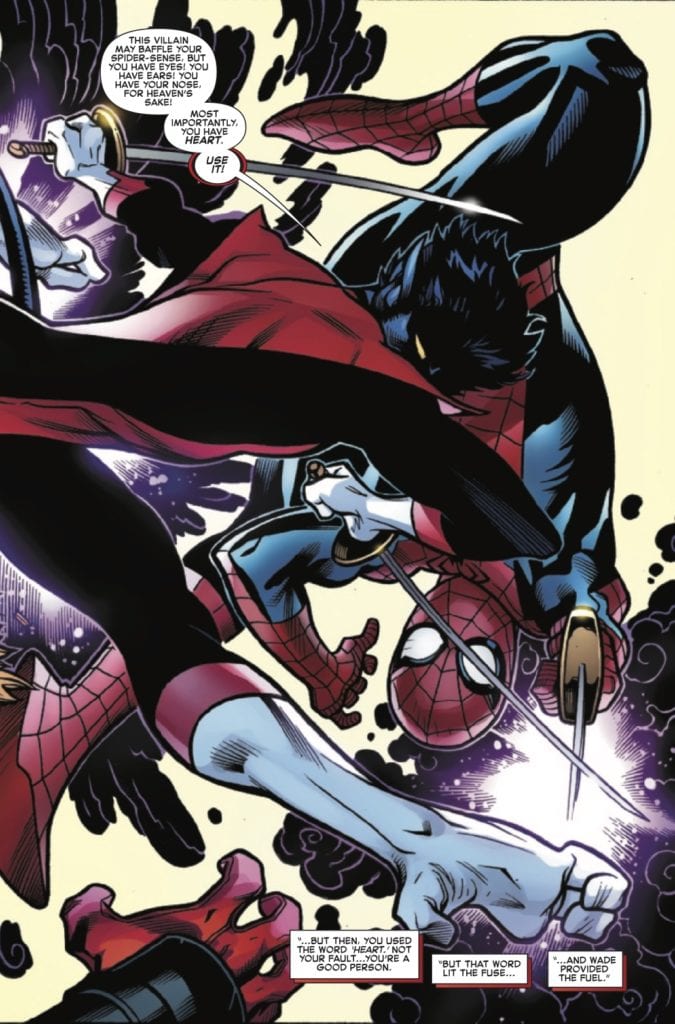SPIDER-MAN/DEADPOOL #14, published back in February 2017, takes place in the midst of writer Joe Kelly’s Itsy Bitsy storyline. But unlike most mid-act story arcs, this issue cuts to the heart of the plot in grandeur. Spidey and Deadpool fans will remember the intriguing plot: an unknown antagonist used the two heroes’ cells to create Itsy Bitsy, a being more powerful than both of them. And the duo learns she could easily kill thousands of people. While Deadpool learns to seek alternative ways to combat the creature than his usual M.O., Spidey finds himself drawn to the ever-looming temptation of killing the menace.
Story
In order to prepare for the next Itsy Bitsy attack, Spidey and Deadpool meet with their X-Men ally Kurt Wagner, a.k.a. Nightcrawler. The webbed hero recently lost the ability to tap in his Spidey sense, so Kurt agrees to help him train. However, Kurt notices how much anger Spidey holds and attempts to get to the heart of his frustration.

MFR ON YOUTUBE (latest video)
Help us reach 5K Subs!

Kelly’s narrative isn’t told in chronological order. Though the training with Kurt takes place first, the reader experiences these events as memories in Spidey’s head. These scenes are diagnosed by none other than Kurt himself, acting as Spidey’s personal priest for the issue. After some probing, we soon learn the hero is debating breaking his “no kill rule” due to the immense threat Itsy Bitsy poses. We get to see his personal rationalizations while receiving caring yet firm pushback from Kurt.
Readers find themselves contemplating the ethics of the right to take life alongside their favorite arachnid themed superhero. Kelly helps them get inside Spidey’s head through the confessional framework, showing him locked in a war against his very identity.
Artwork
Ed McGuinness’s penciling, along with Mark Morales’s ink work, Jason Keith’s coloring, and VC’s Joe Sabino’s lettering worked together beautifully. The characters are defined with solid borders, yet retain a sense of fluidity to create a sense of movement. In addition, the coloring gives readers a sense that our three heroes are connected through the use of similar red shading on their outfits. And, to top it all off, the lettering is placed in a way to compliment the action, giving the appearance that the characters are moving around the boxes themselves.
Conclusion
SPIDER-MAN/DEADPOOL #14 did a fantastic job of pushing Spidey to his limits. But we, the reader, had the opportunity to join our hero in the emotional turmoil. We highly recommend revisiting this issue.
Did you enjoy Nightcrawler’s guest appearance? Let us know in the comments below!

